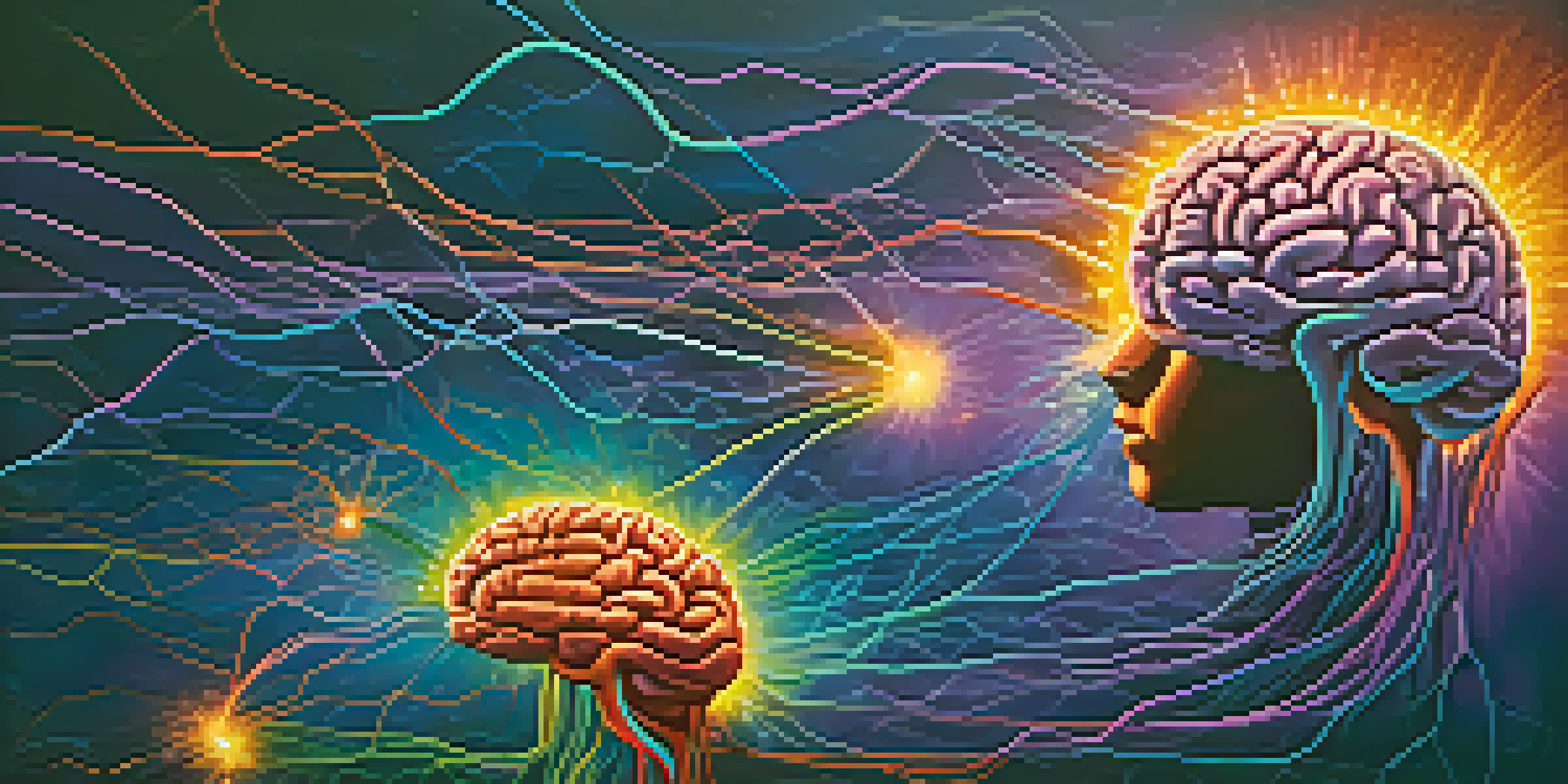Exploring the Neuroscience of Psychedelics and Perception

Understanding Psychedelics: A Brief Overview
Psychedelics, often associated with the counterculture of the 1960s, are substances like LSD, psilocybin, and DMT. These compounds are known for altering perception, mood, and cognition, leading to experiences that can feel profound or enlightening. Their effects can range from visual and auditory hallucinations to deep introspection and emotional release.
Psychedelics can help us understand the nature of consciousness itself, and in doing so, help us heal ourselves and others.
Interestingly, these substances have garnered renewed interest in the scientific community, particularly in neuroscience, where researchers are exploring their potential therapeutic benefits. This resurgence is partly due to emerging studies suggesting that psychedelics may help treat conditions such as depression, PTSD, and anxiety, offering new hope for those unresponsive to traditional treatments.
Understanding the science behind psychedelics begins with examining how they interact with the brain. By binding to serotonin receptors, particularly the 5-HT2A receptor, these substances can dramatically alter neural communication, leading to shifts in perception and consciousness.
The Brain's Default Mode Network and Psychedelics
One of the key areas of study in psychedelic research is the brain's Default Mode Network (DMN). This network is associated with self-referential thoughts and daydreaming, often becoming highly active during introspective moments. When psychedelics are introduced, studies show a marked decrease in DMN activity, which correlates with the feeling of ego dissolution many users report.

This decrease in DMN activity allows for a more interconnected brain, where different regions communicate more freely. It's like a crowded room suddenly becoming quiet, allowing for clearer conversations among previously muffled voices. This phenomenon can lead to new perspectives and insights, often described as a 'reset' for the mind.
Psychedelics and Mental Health
Research shows psychedelics like psilocybin and MDMA may effectively treat mental health disorders such as depression and PTSD.
The implications of this altered brain state are profound. By reducing the dominance of the DMN, psychedelics may facilitate experiences that allow individuals to confront unresolved emotions or traumatic memories, paving the way for healing and personal growth.
Enhanced Perception: How Psychedelics Change Senses
Psychedelics are known to enhance sensory perception, making colors appear more vivid and sounds more resonant. This heightened state can lead to synesthesia, a condition where senses intermingle, such as 'seeing' sounds or 'tasting' colors. For many, these experiences can feel deeply enriching, allowing them to appreciate the world in entirely new ways.
The greatest gift of the psychedelic experience is the ability to see the world through fresh eyes.
This sensory amplification is linked to the way psychedelics affect the brain's processing systems. By disrupting normal communication pathways, they can create a more fluid and dynamic experience of reality. Imagine a world where every detail is heightened, much like an artist who sees every color in a vibrant palette rather than just shades of gray.
While these changes can feel exhilarating, they can also lead to overwhelming sensations. Understanding this aspect of psychedelics is crucial for both users and researchers, as it highlights the need for safe environments and proper guidance when exploring these altered states.
The Role of Neuroplasticity in Psychedelic Experiences
Neuroplasticity, the brain's ability to reorganize itself by forming new neural connections, plays a vital role in the effects of psychedelics. Research indicates that these substances can promote neuroplasticity, potentially aiding in the formation of healthier thought patterns and behaviors. This is especially significant for those struggling with mental health issues.
During psychedelic experiences, users often report insights and realizations that can lead to lasting changes in perspective. This transformative potential suggests that psychedelics may not just offer a temporary escape but rather facilitate long-term psychological benefits. It's akin to clearing out a cluttered room, allowing for new ideas and emotions to flow freely.
The Role of Neuroplasticity
Psychedelics can promote neuroplasticity, aiding the brain in forming healthier thought patterns and facilitating lasting psychological change.
The connection between psychedelics and neuroplasticity opens up exciting possibilities for therapeutic applications. As researchers continue to unravel these complex interactions, the potential for psychedelics to act as catalysts for change in the brain becomes increasingly evident.
Therapeutic Uses: Psychedelics in Mental Health Treatment
In recent years, there has been a growing body of research demonstrating the therapeutic potential of psychedelics in treating various mental health disorders. From clinical trials involving psilocybin for depression to MDMA-assisted therapy for PTSD, these substances are showing promise in providing relief where traditional treatments have failed. This could be a game-changer for many seeking effective solutions.
The therapeutic framework often involves guided sessions where therapists help individuals navigate their experiences, ensuring safety and support. This approach allows for an exploration of emotions and thoughts that might be too daunting to face in a conventional setting. Picture a gentle guide leading you through a dense forest, helping you uncover hidden paths and clearing away emotional obstacles.
As the stigma around psychedelics continues to diminish, more healthcare professionals are advocating for their integration into treatment plans. This shift reflects a broader understanding of mental health, recognizing that healing can take many forms, including those that involve profound, altered states of consciousness.
Challenges and Considerations in Psychedelic Research
Despite the promising research surrounding psychedelics, there are significant challenges that researchers face. Legal restrictions and regulatory hurdles can limit the scope of studies and the types of substances that can be investigated. This is particularly relevant in countries where psychedelics remain classified as illegal drugs, creating barriers to scientific inquiry.
Moreover, the subjective nature of psychedelic experiences complicates research efforts. Each individual's experience can vary widely based on factors like dosage, environment, and personal history. It's akin to trying to quantify a dream—each person's interpretation and experience are unique, making standardized measurements difficult.
Challenges in Psychedelic Research
Legal restrictions and the subjective nature of experiences pose significant challenges to the rigorous study of psychedelics in science.
As the field evolves, it is crucial to strike a balance between enthusiasm for the potential benefits of psychedelics and the need for rigorous scientific methodology. By addressing these challenges head-on, researchers can ensure that the exploration of psychedelics is both responsible and enlightening.
The Future of Psychedelics and Consciousness Exploration
Looking ahead, the future of psychedelics in neuroscience and mental health appears promising. As more studies are conducted and public perception shifts, we may see a broader acceptance of psychedelics as legitimate therapeutic tools. This could lead to new protocols and practices that prioritize safety, efficacy, and ethical considerations.
The exploration of consciousness itself is another fascinating frontier. Psychedelics may serve as a bridge to understanding complex questions about the nature of reality, perception, and the self. Imagine standing at the edge of a vast ocean, ready to dive into its depths, uncovering secrets that have long been hidden beneath the surface.

As we continue to unravel the mysteries of the brain and consciousness, psychedelics hold a unique position at the intersection of science, spirituality, and psychology. The journey of understanding these substances is just beginning, and the insights gained could profoundly reshape our approach to mental health and human experience.